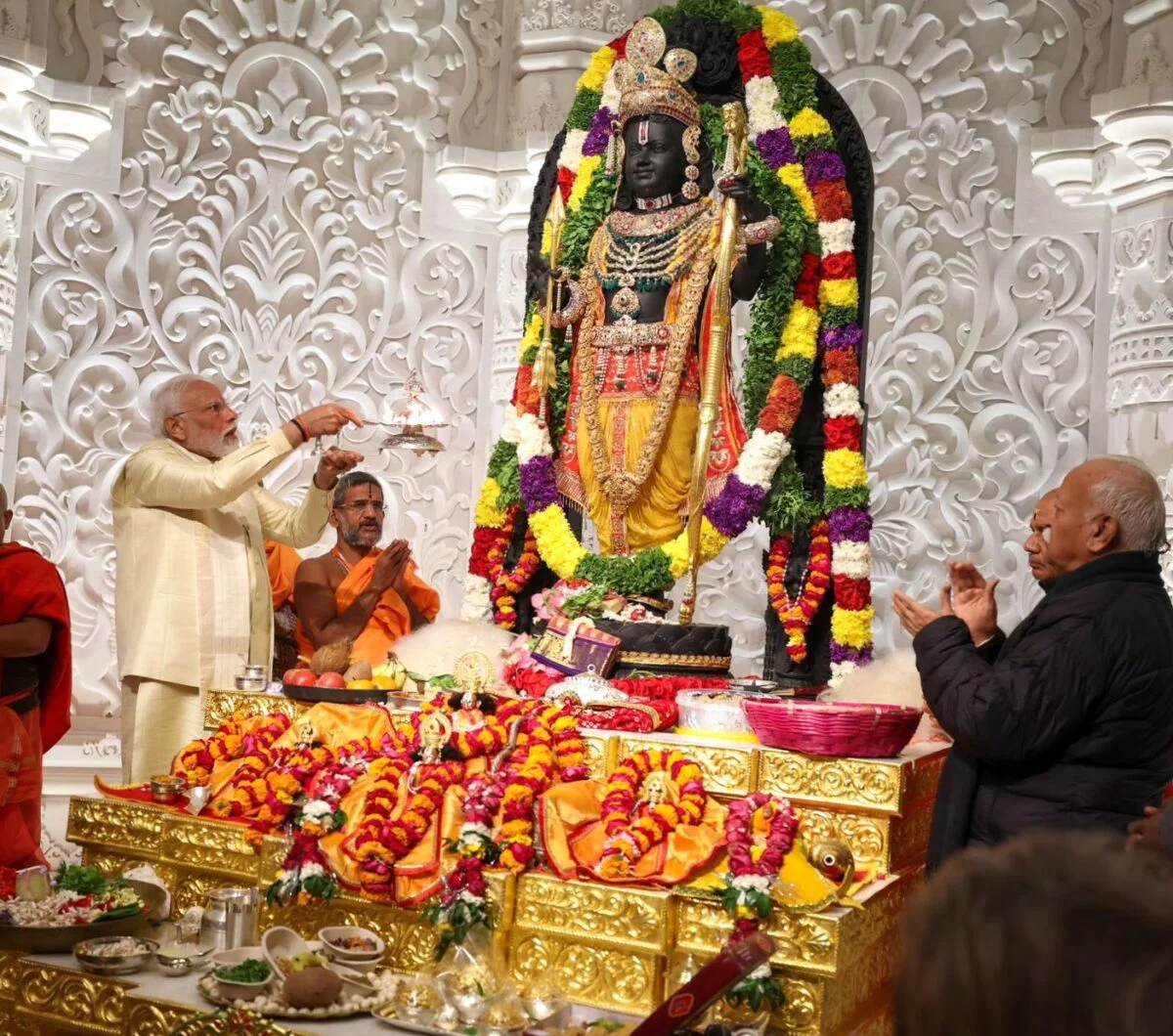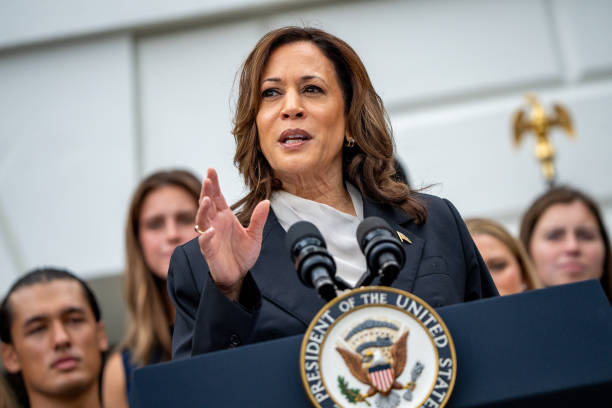
Ayodhya : Prime minister Narendra Modi inaugurated the Ayodhya Ram Temple on January 22, 2024. During the Pran-Pratishtha (consecration) ceremony, the idol of Ram Lalla was installed in the sanctum- sanctorum (garbha-griha) of the temple. The consecration ceremony started at 12.20 PM in and was completed by 1 PM.
The Pran-Pratishtha ceremony at Ayodhya Ram Temple was graced by the majestic Mangal Dhwani at 10 AM. Over 50 exquisite instruments from different states of India were played together for this auspicious occasion, resonating for nearly two hours. Orchestrated by Ayodhya’s own Yatindra Mishra, this grand musical rendition is supported by the Sangeet Natak Akademi, New Delhi.
There will be two idols of Lord Ram. One will be the actual idol found in 1949 and has been in the tent for decades. The other will be a huge statue which will be visible from a long distance.
A dark-coloured idol of Lord Ram sculpted by Arun Yogiraj has been selected for installation at the sanctum- sanatorium (garbha griha) of the Ayodhya Ram Mandir, the trust overseeing the construction work said on January 15. According to Ram Janmabhoomi Teerth Kshetra Trust Secretary Champat Rai, 11 of the 15 members of the trust voted in favour of the idol made by Mysore-based artist Yogiraj.
“The idol made of Lord Shri Ram Lalla is in the form of a five-year-old child. The statue is 51 inches tall, made of black stone, and is very attractively made,” Rai told media. The idol will be placed at the ground floor of the three-storey temple, Rai added.
Ram Lalla idol shringaar
According to the Shri Ram Janmbhoomi Teerth Kshetra Trust, various ornaments have been used to adorn Ram Lalla idol “based on extensive research and study following the descriptions of Shri Ram’s scripturally appropriate splendour in texts such as the Adhyatma Ramayana, Valmiki Ramayana, Ramcharitmanas, and Alavandar Stotra”. “Following this research, and as per concept and direction of Shri Yatindra Mishra, these ornaments have been crafted by Shri Ankur Anand’s institution, Harsahaimal Shiamlal Jewellers, Lucknow.
Yellow angavastram, red pataka
The shyamvarna idol is adorned in Banarasi fabric, featuring a yellow dhoti and a red pataka/angavastram. These angavastrams are embellished with pure gold zari and threads, featuring auspicious Vaishnav symbols, Shankh, Padma, Chakra and Mayur. These garments were created by Delhi’s textile designer, Manish Tripathi.
Mukut
The gold crown is embedded with rubies, emeralds and diamonds. Crafted in North Indian tradition, the mukut features an emblem of the Sun God. On the right side of the crown, strands of pearls are woven.
Tilak
The forehead of the idol is created with diamonds and rubies.
Kundal
Designed to complement the crown, the kundal (earrings) follows the same design pattern with peacock motifs. This piece of jewellery is embellished with gold, diamonds, rubies and emerald.
Kantha
The idol is adorned with a crescent-shaped necklace, studded with gems. It features floral designs symbolising good fortune, with an image of Surya Dev at the centre.
Kaustubh Mani
The heart of the idol is adorned with Kaustubh Mani, decorated with large ruby and diamonds. According to the spiritual tradition, Lord Vishnu and all his avatars wear the Kaustubh Mani on their heart.
Padika
This is a five-layered necklace, made of diamonds and emeralds, fearing an ornate pendant.
Vijayamala
This is the longest necklace the Lord is wearing. The gold necklace studded with rubies has symbols of Vaishnava tradition, the Sudarshana chakra, a lotus, a shankh and the mangal kalash.
Kanchi/Kardhani
Adorning the waist of the Lord is the gold Kardhani (waistband), studded with diamonds, rubies, pearls and emeralds. It also features small bells.
Bajuband
The arms are adorned with gold armlets, featuring precious stones.
Kangan
The gold bangles are also gem studded.
Mudrika
The rings on the fingers are also studded with gems and dangling pearls.
Gold bow in left hand
In his left hand, the 5-year-old Ram idol holds a bow made of gold and studded with pearl, rubies and emerald.
Paijaniya
Gem-studded anklets and toe rings adorn the feet and toenails of the Lord.
Golden umbrella
A resplendent umbrella is set over the Lord’s halo.
Toys for Ram Lalla
Toys made of silver have been kept close to the idol. These toys include a rattle, an elephant, a horse, a camel, a toy cart, and a spinning top.
The temple bell and Nagada
Gujarat has gifted a majestic 2,100-kg Ashtadhatu bell. Alongside, Gujarat also presents a 700-kg chariot carrying a special nagada crafted by the All India Darbar Samaj.
Doors and window
To build the windows and doors, Teak wood (Sagwan) has been procured from Maharashtra’s Chandrapur. Not an ordinary wood, Teak has a life span of over 100 years.
Ayodhya Ram Mandir: Lifespan
The grand structure is being built to have a lifespan of over 1,000 years. “Each material, which is being used…each design and drawing that is being used…is being done in IIT Chennai. They are the initiators. That is then tested by L&T and TCE. Finally, we have given the stability test for this agenda of 1,000 years to the Central Research Building Institute. The CRBI has tested the entire load that will come onto the structure through simulations. In short, we are dependent on the best brains of this country. There is just one objective – how to make this temple durable for 1,000 years and unique,” Nripendra Misra, the chairman of the Shri Ram Janmabhoomi Teerth Kshetra Trust’s temple construction committee, said.
Number of pilgrims to Ayodhya Ram Mandir
Over 50,000 people visit the temple every day. This number is expected to increase to 100,000 once the temple is inaugurated.
Ayodhya Ram Mandir Darshan timing
| Day | Timing |
| Sunday | 7:00 AM to 11:30 AM2:00 PM to 7:00 PM |
| Monday | 7:00 AM to 11:30 AM2:00 PM to 7:00 PM |
| Tuesday | 7:00 AM to 11:30 AM2:00 PM to 7:00 PM |
| Wednesday | 7:00 AM to 11:30 AM2:00 PM to 7:00 PM |
| Thursday | 7:00 AM to 11:30 AM2:00 PM to 7:00 PM |
| Friday | 7:00 AM to 11:30 AM2:00 PM to 7:00 PM |
| Saturday | 7:00 AM to 11:30 AM2:00 PM to 7:00 PM |
Ayodhya Ram Mandir Morning Aarti (Shiringar Aarti) timing
| Day | Timing |
| Sunday | 6:30 AM |
| Monday | 6:30 AM |
| Tuesday | 6:30 AM |
| Wednesday | 6:30 AM |
| Thursday | 6:30 AM |
| Friday | 6:30 AM |
| Saturday | 6:30 AM |
Ayodhya Ram Mandir Evening Aarti (Sandhya Aarti) timing
| Day | Timing |
| Sunday | 7:30 PM |
| Monday | 7:30 PM |
| Tuesday | 7:30 PM |
| Wednesday | 7:30 PM |
| Thursday | 7:30 PM |
| Friday | 7:30 PM |
| Saturday | 7:30 PM |
| Ayodhya Ram Mandir: Timeline1528-1529: Mughal emperor Babur builds Babri Masjid1850s: Start of communal violence over the land1949: Ram Idol found inside the mosque, intensifying communal tension1950: Two suits filed in Faizabad civil court seeking permission to worship the idol1961: UP Sunni Central Wakf Board demands the removal of the idol1986: District Court opens the site for Hindu worshippers1992: Babri masjid demolished on December 62010: Allahabad HC rules three-way division of disputed area among Sunni Waqf Board, Nirmohi Akhara and Ram Lalla2011: SC stays Allahabad HC order2016: Subramanian Swamy files plea in SC, seeks the construction of Ram Temple2019: SC accepts Ayodhya was the birthplace of Lord Ram, hands over the entire 2.77 acres of disputed land to the trust and orders the government to give 5-acre land to Sunni Waqf Board as an alternate site2020: PM Modi performs Bhumi Poojan and lays the foundation stone |
How to reach Ayodhya?
By Air: You can book flights to the Ayodhya Airport from every major Indian city. The airport is conveniently connected to the city centre through the modes of taxi and auto rickshaws.
By Road: Ayodhya is well-connected by road to nearby cities and towns. You can hire a taxi or use public transportation like buses to reach Ayodhya from nearby locations. The airport is located approximately 8-10 km from the city centre.
By Train: The nearest major railway station to Ayodhya is the Ayodhya Junction. From there, you can take a taxi or an auto-rickshaw to reach Ayodhya Airport. The distance is around 6-8 km.
Ayodhya Ram Mandir: Impact on real estate
Land rates in and around Ayodhya have risen by up to 10 times in the past decade, property dealers and brokers active in the area inform.
“Land bought for lakhs in the city before the announcement of the temple construction overnight became crore-worthy after the Supreme Court verdict. With big developers showing interest in property here, rates have gone up further, brining the city on a par with state capital Lucknow, to say the least,” says Lal Babu Pandey, an Ayodhya resident who worked only as a part-time property dealer earlier.
The interest in land is now so much that that it has turned into a full-time occupation for me and is enough to support my family, informs Pandey.
To find a land parcel within a radius of 5-10 km of the temple a buyer will have to spend at least Rs 2,000 per square foot while rates might go as high as Rs 18,000 per square foot. Prices for commercial plots start at Rs 4,000 per square foot, and can go up to Rs 20,000 per square foot. In some pockets, the rate for one biswa of land is now over Rs 60 lakh which used to be Rs 5 lakh till 2018.





